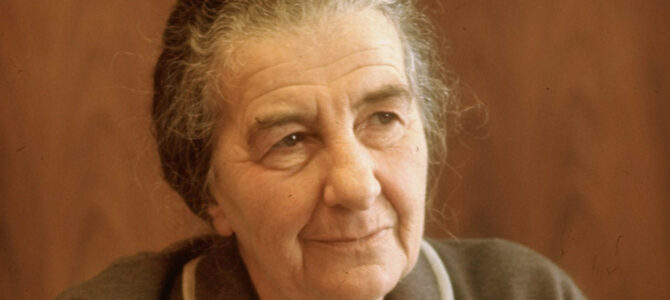by Yvette Alt Miller, August 24, 2023
There’s a lot you don’t know about Israel’s Iron Lady.
The new movie Golda depicts former Israeli prime minister Golda Meir’s day-by-day decisions during the Yom Kippur War of 1973. Viewers watch as Golda, played by Helen Mirren, juggles high-stakes diplomacy and brinkmanship over 19 excruciating days which defined her premiership. Israel ultimately won the war but with a terrible loss of life.
Here are 11 lesser-known facts about Golda Meir, one of Israel’s most famous founders.
1. Golda’s first memory was fearing for her life.
Born in Kiev, Ukraine in 1898, Golda spent her first eight years in the shadow of horrific antisemitism there. Her very first memory was of her father Moshe desperately trying to reinforce the entrance to the little house they shared with another Jewish family while a violent mob brayed for blood outside.
Golda later described:
I can still recall quite distinctly hearing about a pogrom that was to descend upon us… I knew it had something to do with being Jewish and with the rabble that used to surge through town, brandishing knives and huge sticks, screaming “Christ-killers” as they looked for the Jews and who were now going to do terrible things to me and to my family…to this day I remember how scared I was and how angry that all my father could do to protect me was to nail a few planks together while he waited for the hooligans to come. (Quoted from My Life by Golda Meir: 1975)
Golda later described that the fear of that terrible night never left her, and helped motivate her to build a Jewish state where Jews could live freely in safety.
2. Her namesake was a Jewish grandma with a will of steel.
Golda was named after her great grandmother, who was known for having a will of iron in the family. When Golda’s father Moshe asked her mother Blume to marry him, Blume’s family opposed the match, claiming that Moshe wasn’t accomplished enough for their daughter. Great grandma Golda intervened, firmly telling the family that the only quality that really mattered was being a mensch, a quality that described Moshe to a tee. The marriage went ahead.
Great grandma Golda had a curious habit: instead of putting sugar in her tea, she flavored it with salt to remind herself of the bitterness of the Diaspora, when Jews were exiled from their homeland in Israel.
3. Her activism began at age 10.
Golda Meir’s family migrated to the United States, settling in Milwaukee. When she was ten years old, Golda’s elementary school suddenly announced that instead of using second-hand textbooks, all students had to purchase new books. Golda’s immigrant family, like many impoverished families in her Jewish neighborhood, couldn’t afford the expense. So Golda swung into action helping to form a student club to raise money for new books. Golda and her friends rented out a hall and put on a show; Golda recited poems in Yiddish for a paying audience. Afterwards, she described that fundraising experience as her first “public work.”
4. Golda Meir ran away from home.
As she grew into a teenager, Golda repeatedly clashed with her parents. They wanted her to marry young, while Golda wanted to focus on higher education. One day, Golda ran away from home and moved in with her older sister Sheyna who was living in Denver. There Golda attended high school and met Sheyna’s passionately Zionist friends who used to fill Sheyna’s apartment every evening, debating how they could best bring about the creation of a Jewish state.
Her time in Denver changed Golda’s life: she became a feisty political actor, and met her husband, Morris, who was one of the Zionist intellectuals who used to gather in Sheyna’s home.
5. Golda trained as a Milwaukee schoolteacher.
Returning to Milwaukee, Golda enrolled in a teacher training college and taught Yiddish in the evenings at a Yiddish language school to Jewish immigrants and their children. She never worked as a teacher and in 1921 moved to the Land of Israel with her husband Morris. The elementary school that Golda Meir attended in Milwaukee still exists and is now known as the Golda Meir School.
Full article here.


